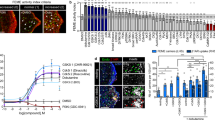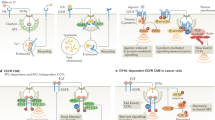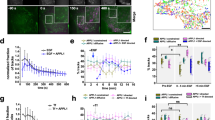Abstract
Signal transduction and endocytosis are intertwined processes. The internalization of ligand-activated receptors by endocytosis has classically been thought to attenuate signals by targeting receptors for degradation in lysosomes, but it can also maintain signals in early signalling endosomes. In both cases, localization to multivesicular endosomesen route to lysosomes is thought to terminate signalling. However, during WNT signal transduction, sequestration of the enzyme glycogen synthase kinase 3 (GSK3) inside multivesicular endosomes results in the stabilization of many cytosolic proteins. Thus, the role of endocytosis during signal transduction may be more diverse than anticipated, and multivesicular endosomes may constitute a crucial signalling organelle.
This is a preview of subscription content, access via your institution
Access options
Subscribe to this journal
Receive 12 print issues and online access
$189.00 per year
only $15.75 per issue
Buy this article
- Purchase on Springer Link
- Instant access to full article PDF
Prices may be subject to local taxes which are calculated during checkout




Similar content being viewed by others
References
Katzmann, D. J., Odorizzi, G. & Emr, S. D. Receptor downregulation and multivesicular-body sorting. Nature Rev. Mol. Cell Biol. 12, 893–905 (2002).
Piper, R. C. & Katzmann, D. J. Biogenesis and function of multivesicular bodies. Annu. Rev. Cell Dev. Biol. 23, 519–547 (2007).
McKanna, J. A., Haigler, H. T. & Cohen, S. Hormone receptor topology and dynamics: morphological analysis using ferritin-labeled epidermal growth factor. Proc. Natl Acad. Sci. USA 76, 5689–5693 (1979).
Hurley, J. H. ESCRT complexes and the biogenesis of multivesicular bodies. Curr. Opin. Cell Biol. 20, 4–11 (2008).
Raiborg, C. & Stenmark, H. The ESCRT machinery in endosomal sorting of ubiquitylated membrane proteins. Nature 458, 445–452 (2009).
Sorkin, A. & von Zastrow, M. Endocytosis and signalling: intertwining molecular networks. Nature Rev. Mol. Cell Biol. 10, 609–622 (2009).
García-Regalado, A. et al. G protein-coupled receptor-promoted trafficking of Gβ1γ2 leads to AKT activation at endosomes via a mechanism mediated by Gβ1γ2-Rab11a interaction. Mol. Biol. Cell 19, 4188–4200 (2008).
Grimes, M. L. et al. Endocytosis of activated TrkA: evidence that nerve growth factor induces formation of signaling endosomes. J. Neurosci. 16, 7950–7964 (1996).
Watson, F. L. et al. Neurotrophins use the Erk5 pathway to mediate a retrograde survival response. Nature Neurosci. 4, 981–988 (2001).
Tsukazaki, T., Chiang, T. A., Davison, A. F., Attisano, L. & Wrana, J. L. SARA, a FYVE domain protein that recruits Smad2 to the TGFβ receptor. Cell 95, 779–791 (1998).
Hayes, S., Chawla, A. & Corvera, S. TGFβ receptor internalization into EEA1-enriched early endosomes: role in signaling to Smad2. J. Cell Biol. 158, 1239–1249 (2002).
Taelman, V. F. et al. Wnt signaling requires sequestration of glycogen synthase kinase 3 inside multivesicular endosomes. Cell 143, 1136–1148 (2010).
Bilic, J. et al. Wnt induces LRP6 signalosomes and promotes Dishevelled-dependent LRP6 phosphorylation. Science 316, 1619–1622 (2007).
Zeng, X. et al. Initiation of Wnt signaling: control of Wnt coreceptor Lrp6 phosphorylation/activation via Frizzled, Dishevelled and Axin functions. Development 135, 367–375 (2008).
Metcalfe, C., Mendoza-Topaz, C., Mieszczanek, J. & Bienz, M. Stability elements in the LRP6 cytoplasmic tail confer efficient signalling upon DIX-dependent polymerization. J. Cell Sci. 123, 1588–1599 (2010).
Mi, K., Dolan, P. J. & Johnson, G. V. W. The low density lipoprotein receptor-related protein 6 interacts with glycogen synthase kinase 3 and attenuates activity. J. Biol. Chem. 281, 4787–4794 (2006).
Cselenyi, C. S. et al. LRP6 transduces a canonical Wnt signal independently of Axin degradation by inhibiting GSK3's phosphorylation of β-catenin. Proc. Natl Acad. Sci. USA 105, 8032–8037 (2008).
Piao, S. et al. Direct inhibition of GSK3β by the phosphorylated cytoplasmic domain of LRP6 in Wnt/β-catenin signaling. PLoS ONE 3, e4046 (2008).
Wu, G., Huang, H., Garcia Abreu, J. & He, X. Inhibition of GSK3 phosphorylation of β-catenin via phosphorylated PPPSPXS motifs of Wnt coreceptor LRP6. PLoS ONE 4, e4926 (2009).
Ding, V. W., Chen, R. H. & McCormick, F. Differential regulation of glycogen synthase kinase 3β by insulin and Wnt signaling. J. Biol. Chem. 275, 32475–32481 (2000).
Blitzer, J. T. & Nusse, R. A critical role for endocytosis in Wnt signaling. BMC Cell Biol. 7, 28 (2006).
Platta, H. W. & Stenmark, H. Endocytosis and signaling. Curr. Opin. Cell. Biol. 23, 393–403 (2011).
Kleijmeer, M. et al. Reorganization of multivesicular bodies regulates MHC class II antigen presentation by dendritic cells. J. Cell Biol. 155, 53–63 (2001).
Cohen, P. & Frame, S. The renaissance of GSK3. Nature Rev. Mol. Cell Biol. 2, 769–776 (2001).
Logan, C. Y. & Nusse, R. The Wnt signaling pathway in development and disease. Annu. Rev. Cell Dev. Biol. 20, 781–810 (2004).
Clevers, H. Wnt/β-catenin signaling in development and disease. Cell 127, 469–480 (2006).
Yamamoto, H., Komekado, H. & Kikuchi, A. Caveolin is necessary for Wnt-3a-dependent internalization of LRP6 and accumulation of β-catenin. Dev. Cell 11, 213–223 (2006).
Wegener, C. S. et al. Ultrastructural characterization of giant endosomes induced by GTPase-deficient Rab5. Histochem. Cell Biol. 133, 41–55 (2010).
Jékely, G. & Rørth, P. Hrs mediates downregulation of multiple signalling receptors in Drosophila. EMBO Rep. 4, 1163–1168 (2003).
Stern, K. A. et al. Epidermal growth factor receptor fate is controlled by Hrs tyrosine phosphorylation sites that regulate Hrs degradation. Mol. Cell. Biol. 27, 888–898 (2007).
Malerød, L., Stuffers, S., Brech, A. & Stenmark, H. Vps22/EAP30 in ESCRT-II mediates endosomal sorting of growth factor and chemokine receptors destined for lysosomal degradation. Traffic 8, 1617–1629 (2007).
Bache, K. G. et al. The ESCRT-III subunit hVps24 is required for degradation but not silencing of the epidermal growth factor receptor. Mol. Biol. Cell 17, 2513–2523 (2006).
Chanut-Delalande, H. et al. The Hrs/Stam complex acts as a positive and negative regulator of RTK signaling during Drosophila development. PLoS ONE 5, e10245 (2010).
Toyoshima, M. et al. Inhibition of tumor growth and metastasis by depletion of vesicular sorting protein Hrs: its regulatory role on E-cadherin and β-catenin. Cancer Res. 67, 5162–5171 (2007).
Falguières, T., Luyet, P. P. & Gruenberg, J. Molecular assemblies and membrane domains in multivesicular endosome dynamics. J. Exp. Cell Res. 315, 1567–1573 (2009).
Von Bartheld, C. S. & Altick, A. L. Multivesicular bodies in neurons: distribution, protein content, and trafficking functions. Prog. Neurobiol. 93, 313–340 (2011).
Fuentealba, L. C. et al. Integrating patterning signals: Wnt/GSK3 regulates the duration of the BMP/Smad1 signal. Cell 131, 980–993 (2007).
Eivers, E., Demagny, H., Choi, R. H. & De Robertis, E. M. A molecular competition between wingless and BMP signaling controlled by mad phosphorylations. Sci. Signal. 4, ra68 (2011).
Wu, D. & Pan, W. GSK3: a multifaceted kinase in Wnt signaling. Trends Biochem. Sci. 35, 161–168 (2010).
Jope, R. S. & Johnson, G. V. The glamour and gloom of glycogen synthase kinase-3. Trends Biochem. Sci. 29, 95–102 (2004).
Kim, N. G., Xu, C. & Gumbiner, B. M. Identification of targets of the Wnt pathway destruction complex in addition to β-catenin. Proc. Natl Acad. Sci. USA 106, 5165–5170 (2009).
Huang, H. R., Chen, Z. J., Kunes, S., Chang, G. D. & Maniatis, T. Endocytic pathway is required for Drosophila Toll innate immune signaling. Proc. Natl Acad. Sci. USA 107, 8322–8327 (2010).
Luttrell, L. M. et al. β-arrestin-dependent formation of β2 adrenergic receptor-Src protein kinase complexes. Science 283, 655–661 (1999).
Ahn, S., Maudsley, S., Luttrell, L. M., Lefkowitz, R. J. & Daaka, Y. Src-mediated tyrosine phosphorylation of dynamin is required for β2-adrenergic receptor internalization and mitogen-activated protein kinase signaling. J. Biol. Chem. 274, 1185–1188 (1999).
Hanyaloglu, A. C., McCullagh, E. & von Zastrow, M. Essential role of Hrs in a recycling mechanism mediating functional resensitization of cell signaling. EMBO J. 24, 2265–2283 (2005).
Devergne, O., Ghiglione, C. & Noselli, S. The endocytic control of JAK/STAT signalling in Drosophila. J. Cell Sci. 120, 3457–3464 (2007).
Vidal, O. M., Stec, W., Bausek, N., Smythe, E. & Zeidler, M. P. Negative regulation of Drosophila JAK–STAT signalling by endocytic trafficking. J. Cell Sci. 123, 3457–3466 (2010).
Coumailleau, F., Fürthauer, M., Knoblich, J. A. & González-Gaitán, M. Directional Delta and Notch trafficking in Sara endosomes during asymmetric cell division. Nature 458, 1051–1055 (2009).
Wilkin, M. et al. Drosophila HOPS and AP-3 complex genes are required for a Deltex-regulated activation of notch in the endosomal trafficking pathway. Dev. Cell 15, 762–772 (2008).
Fürthauer, M. & González-Gaitán, M. Endocytic regulation of notch signalling during development. Traffic 10, 792–802 (2009).
Rowning, B. A. et al. Microtubule-mediated transport of organelles and localization of β-catenin to the future dorsal side of Xenopus eggs. Proc. Natl Acad. Sci. USA 94, 1224–1229 (1997).
Weaver, C. & Kimelman, D. Move it or lose it: axis specification in Xenopus. Development 131, 3491–3499 (2004).
Nieuwkoop, P. D. Origin and establishment of embryonic polar axes in amphibian development. Curr. Top. Dev. Biol. 11, 115–132 (1977).
Black, S. D. & Gerhart, J. C. High-frequency twinning of Xenopus laevis embryos from eggs centrifuged before first cleavage. Dev. Biol. 116, 228–240 (1986).
McMahon, A. P. & Moon, R. T. Ectopic expression of the proto-oncogene int-1 in Xenopus embryos leads to duplication of the embryonic axis. Cell 58, 1075–1084 (1989).
De Robertis, E. M. Spemann's organizer and self-regulation in amphibian embryos. Nature Rev. Mol. Cell Biol. 7, 296–302 (2006).
Leyns, L., Bouwmeester, T., Kim, S. H., Piccolo, S. & De Robertis, E. M. Frzb-1 is a secreted antagonist of Wnt signaling expressed in the Spemann organizer. Cell 88, 747–756 (1997).
Opresko, L., Wiley, H. S. & Wallace, R. A. Differential postendocytotic compartmentation in Xenopus oocytes is mediated by a specifically bound ligand. Cell 22, 47–57 (1980).
Balinsky, B. I. Changes in the ultrastructure of amphibian eggs following fertilization. Acta Embryol. Morphol. Exp. 9, 132–154 (1966).
Miller, J. R. et al. Establishment of the dorsal–ventral axis in Xenopus embryos coincides with the dorsal enrichment of Dishevelled that is dependent on cortical rotation. J. Cell Biol. 146, 427–437 (1999).
Tao, Q. et al. Maternal Wnt11 activates the canonical Wnt signaling pathway required for axis formation in Xenopus embryos. Cell 120, 857–871 (2005).
Sotelo, J. R. & Porter, K. R. An electron microscope study of the rat ovum. J. Biophys. Biochem. Cytol. 5, 327–342 (1959).
Young, T. W. et al. Up-regulation of tumor susceptibility gene 101 conveys poor prognosis through suppression of p21 expression in ovarian cancer. Clin. Cancer Res. 13, 3848–3854 (2007).
Oh, K. B., Stanton, M. J., West, W. W., Todd, G. L. & Wagner, K. U. Tsg101 is upregulated in a subset of invasive human breast cancers and its targeted overexpression in transgenic mice reveals weak oncogenic properties for mammary cancer initiation. Oncogene 26, 5950–5959 (2007).
Liu, R. T. et al. Overexpression of tumor susceptibility gene TSG101 in human papillary thyroid carcinomas. Oncogene 21, 4830–4837 (2002).
Vaccari, T. & Bilder, D. The Drosophila tumor suppressor vps25 prevents nonautonomous overproliferation by regulating notch trafficking. Dev. Cell 9, 687–698 (2005).
Thompson, B. J. et al. Tumor suppressor properties of the ESCRT-II complex component Vps25 in Drosophila. Dev. Cell 9, 711–720 (2005).
Li, J., Belogortseva, N., Porter, D. & Park, M. Chmp1A functions as a novel tumor suppressor gene in human embryonic kidney and ductal pancreatic tumor cells. Cell Cycle 7, 2886–2893 (2008).
Wilson, E. M., Oh, Y., Hwa, V. & Rosenfeld, R. G. Interaction of IGF-binding protein-related protein 1 with a novel protein, neuroendocrine differentiation factor, results in neuroendocrine differentiation of prostate cancer cells. J. Clin. Endocrinol. Metab. 86, 4504–4511 (2001).
Babst, M. A protein's final ESCRT. Traffic 6, 2–9 (2005).
Babst, M., Wendland, B., Estepa, E. J. & Emr, S. D. The Vps4p AAA ATPase regulates membrane association of a Vps protein complex required for normal endosome function. EMBO J. 17, 2982–2993 (1998).
Fernandez-Borja . et al. Multivesicular body morphogenesis requires phosphatidyl-inositol 3-kinase activity. Curr. Biol. 9, 55–58 (1999).
Stoorvogel, W., Strous, G. J., Geuze, H. J., Oorschot, V. & Schwartz, A. L. Late endosomes derive from early endosomes by maturation. Cell 65, 417–427 (1991).
Ohashi, M., Miwako, I., Yamamoto, A. & Nagayama, K. Arrested maturing multivesicular endosomes observed in a Chinese hamster ovary cell mutant, LEX2, isolated by repeated flow-cytometric cell sorting. J. Cell Sci. 113, 2187–2205 (2000).
Maxfield, F. R. & McGraw, T. E. Endocytic recycling. Nature Rev. Mol. Cell Biol. 5, 121–132 (2004).
Woodman, P. G. & Futter, C. E. Multivesicular bodies: co-ordinated progression to maturity. Curr. Opin. Cell Biol. 20, 408–414 (2008).
Raiborg, C., Rusten, T. E. & Stenmark, H. Protein sorting into multivesicular endosomes. Curr. Opin. Cell Biol. 15, 446–455 (2003).
Gruenberg, J. & Stenmark, H. The biogenesis of multivesicular endosomes. Nature Rev. Mol. Cell Biol. 5, 317–323 (2004).
Harding, C., Heuser, J. & Stahl, P. Receptor-mediated endocytosis of transferrin and recycling of the transferrin receptor in rat reticulocytes. J. Cell Biol. 97, 329–339 (1983).
Denzer, K., Kleijmeer, M. J., Heijnen, H. F., Stoorvogel, W. & Geuze, H. J. Exosome: from internal vesicle of the multivesicular body to intercellular signaling device. J. Cell Sci. 113, 3365–3374 (2000).
Février, B. & Raposo, G. Exosomes: endosomal-derived vesicles shipping extracellular messages. Curr. Opin. Cell Biol. 16, 415–421 (2004).
Murk, J. L., Stoorvogel, W., Kleijmeer, M. J. & Geuze, H. J. The plasticity of multivesicular bodies and the regulation of antigen presentation. Semin. Cell Dev. Biol. 13, 303–311 (2002).
Sahu, R. et al. Microautophagy of cytosolic proteins by late endosomes. Dev. Cell 20, 131–139 (2011).
Cruciat, C. M. et al. Requirement of prorenin receptor and vacuolar H+-ATPase-mediated acidification for Wnt signaling. Science 327, 459–463 (2010).
MacDonald, B. T., Tamai, K. & He, X. Wnt/β-catenin signaling: components, mechanisms, and diseases. Dev. Cell 17, 9–26 (2009).
Acknowledgements
We thank members of our laboratory for comments on the manuscript, the Deutsche Forschungsgemeinschaft for supporting R.D. and the US National Institutes of Health for support. E.M.D.R. is an Investigator of the Howard Hughes Medical Institute.
Author information
Authors and Affiliations
Corresponding author
Ethics declarations
Competing interests
The authors declare no competing financial interests.
Related links
Rights and permissions
About this article
Cite this article
Dobrowolski, R., De Robertis, E. Endocytic control of growth factor signalling: multivesicular bodies as signalling organelles. Nat Rev Mol Cell Biol 13, 53–60 (2012). https://doi.org/10.1038/nrm3244
Published:
Issue Date:
DOI: https://doi.org/10.1038/nrm3244
This article is cited by
-
Morphological aspects of oogenesis in the deep-sea clam Calyptogena pacifica (Pliocardiinae; Vesicomyidae)
Marine Biology (2024)
-
The WNT/β-catenin system in chronic kidney disease-mineral bone disorder syndrome
International Urology and Nephrology (2023)
-
The ESCRT-0 subcomplex component Hrs/Hgs is a master regulator of myogenesis via modulation of signaling and degradation pathways
BMC Biology (2021)
-
RAB31 marks and controls an ESCRT-independent exosome pathway
Cell Research (2021)
-
Wnt-inducible Lrp6-APEX2 interacting proteins identify ESCRT machinery and Trk-fused gene as components of the Wnt signaling pathway
Scientific Reports (2020)



